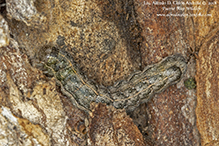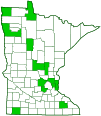Bethune’s pinion
(Lithophane bethunei)
Conservation • Description • Habitat • Ecology • Distribution • Taxonomy
|
|
||||||||||||||||||
Description |
Bethune’s pinion is an early and late season, medium-sized moth. It occurs in the United States east of the Great Plains and in adjacent Canadian provinces. It is common from New England to the Midwest, less common in Minnesota, where it is at the western extent of its range. Adults are active from August through November. They overwinter and may be seen in flight on warm winter days. They are active again from late March to early June. Mature larvae (caterpillars) are found in June and July on the leaves of many woody plants, including apple, ash, basswood, beech, birch, cherry, crabapple, cranberry, elm, hawthorn, hickory, ironwood, maple, oak, poplar, willow, and witch hazel. Late stage (instar) caterpillars have been seen feeding on eastern tent caterpillar pupae. Adults are thick bodied and 11 ⁄16″ to ¾″ (18 to 20 mm) long. They have a wingspan of 1¼″ to 1 9 ⁄16″ (32 to 40 mm). The forewings are long and cream-colored with light brown and yellowish tinting, dark lines, and black dots. The leading (costal) margin is slightly angled inward from the postmedial (PM) line. There are five horizontal lines crossing the forewings; the antemedial (AM) line between the basal and median areas, the median line, the PM line that separates the median area from the postmedial area, the terminal line at the outer margin, and the subterminal (ST) line between the PM and terminal lines. The AM line is straight and is represented by pairs of closely spaced black dots on the veins. The median line is brown or rich brown and has dark shading below it. It is curved downward in the middle and upward approaching the inner and costal margins. The PM line is curved and is represented by pairs of closely spaced black dots on the veins. The ST line is brown or rich brown, slightly curved, and jagged. The terminal line consists of single black dots between the veins. There is a circular spot in the upper median area (orbicular spot) and a kidney-shaped spot at the end of the discal cell (reniform spot). Both spots are pale in the center and partially bordered with brown or rich brown. The orbicular spot is inconspicuous, similar to the background in the center and very little outlined. The reniform spot is yellowish in the center and mostly outlined. The area between the median line and the PM line is often dark-tinged, causing the reniform spot to stand out from the background. There is a blackish rectangular spot in the median area near the inner margin. It is sometimes evident, often faint, but can always be found if looked for. There are also two gray blotches in the terminal area, one at the inner (anal) angle, one in the middle. The hindwings are cream-colored with heavy dark shading and a yellowish fringe. The head and thorax are the same color as the forewings. There is a thick tuft of hair-like scales on the upper side of the thorax that looks like epaulets. The antennae are threadlike on both the male and the female. The pair of small, finger-like processes (labial palps) curving up from the lower part of the head are long, extending at least to the middle of the face. The late instar caterpillar is up to 1⅜″ (40 mm) long and light brown to gray. There is a dark chevron on the upper side of abdominal segments 1 through 7. |
Size |
Total length: 11 ⁄16″ to ¾″ (18 to 20 mm) Wingspan: 1¼″ to 1 9 ⁄16″ (32 to 39 mm) |
Similar Species |
Habitat |
Deciduous forests and woodlands, old fields |
Ecology |
Season |
One generation per year: August to November and late March to early June |
Behavior |
Adults are active at night and will come to lights. The wings are held flat when at rest. |
Life Cycle |
Adults overwinter |
Larva Hosts |
Leaves of many woody plants, including apple, ash, basswood, beech, birch, cherry, crabapple, cranberry, elm, hawthorn, hickory, ironwood, maple, oak, poplar, willow, and witch hazel. |
Adult Food |
|
Distribution |
||
|
Sources 21, 24, 29, 30, 71, 75, 82, 83. Biodiversity occurrence data published by: Minnesota Biodiversity Atlas (accessed through the Minnesota Biodiversity Atlas Portal, bellatlas.umn.edu, 7/18/2025). |
|
| 7/18/2025 | ||
Occurrence |
||
Common |
||
Taxonomy |
|
Order |
Lepidoptera (Butterflies and Moths) |
Superfamily |
Noctuoidea (Owlet Moths and Allies) |
Family |
Noctuidae (cutworm moths and allies) |
Subfamily |
Noctuinae (cutworms and dart moths) |
Tribe |
Xylenini (swordgrasses, pinions, and xylenine sallows) |
| Subtribe | Xylenina |
Genus |
Lithophane |
Section |
Lithophane signosa (dimorphic brown pinions) |
Subordinate Taxa |
|
|
|
Synonyms |
|
Lithophane duscalis Lithophane luteocosta Xylina bethunei |
|
Common Names |
|
Bethune’s pinion Bethune’s pinion moth |
|
Glossary
Antemedial (AM) line
A thin line separating the basal area and the median area of the forewing of Lepidoptera.
Costal margin
The leading edge of the forewing of insects.
Instar
The developmental stage of arthropods between each molt; in insects, the developmental stage of the larvae or nymph.
Orbicular spot
A circular spot or outline in the upper median area near the antemedial line on the forewing of many moths.
Postmedial (PM) line
A thin line separating the median area and the postmedial area of the forewing of Lepidoptera.
Reniform spot
A kidney-shaped spot or outline in the lower median area near the PM line on the forewing of many moths.
Visitor Photos |
||
Share your photo of this insect. |
||
This button not working for you? |
||
Alfredo Colon |
 |
MinnesotaSeasons.com Photos |
||
|
||
|

Slideshows |
|

Visitor Videos |
||
Share your video of this insect. |
||
This button not working for you? |
||
|
Other Videos |
||
|

Created: 12/22/2019 Last Updated: © MinnesotaSeasons.com. All rights reserved. |


